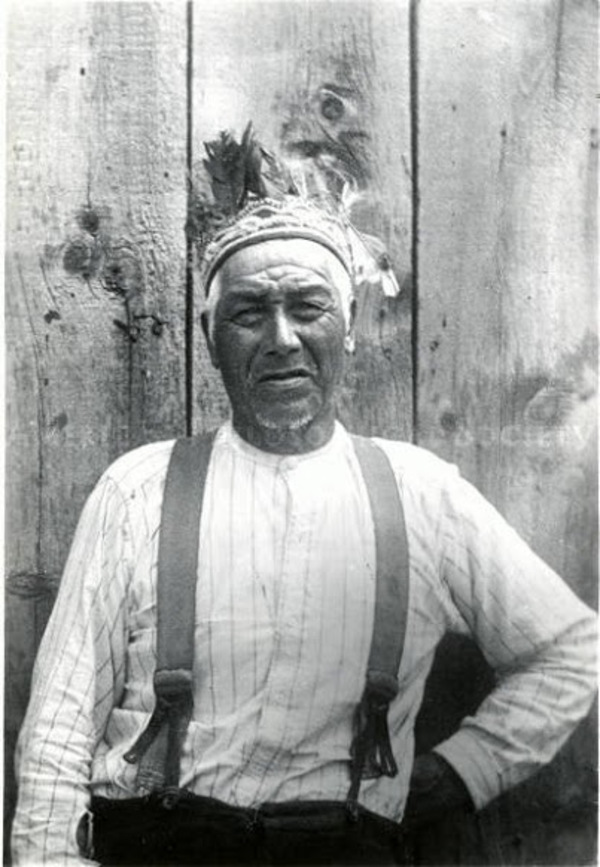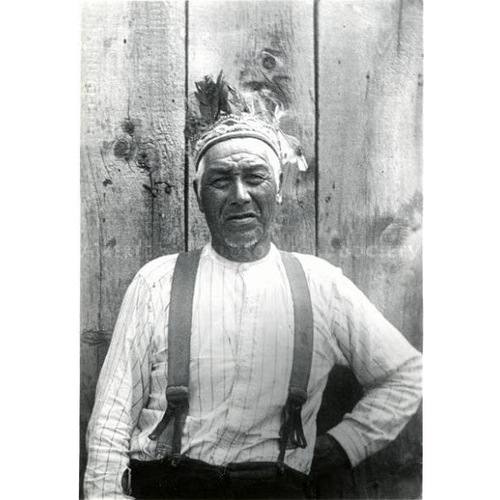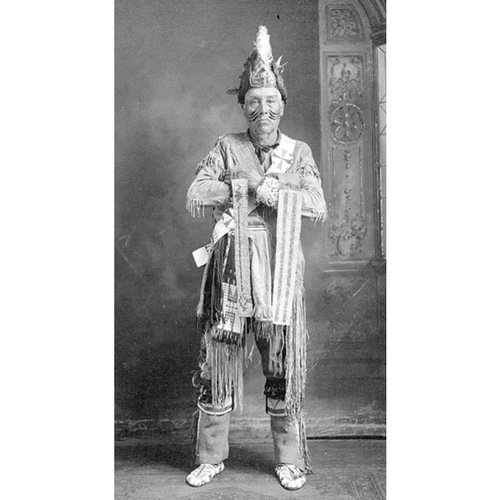
Source: Link
NEWHOUSE, SETH (Dayodekane), farmer, Iroquoian traditionalist, and Onondaga chief; b. 27 Jan. 1842 on the Six Nations Reserve, Upper Canada, son of Nicholas Newhouse and Catherine Martin; m. first Catherine —; m. secondly c. 1892 Lucy Sero, from the Tyendinaga Reserve, Ont., and they had three daughters and a son; d. 11 June 1921 in Tuscarora Township, Ont.
Seth Newhouse’s mother was an Onondaga of the grey swift clan and his father was a Mohawk. He attended the Mohawk Institute, a residential school near Brantford, Ont., and was competent in both Onondaga and English and an eloquent speaker in Mohawk. Although he was raised a member of the Plymouth Brethren and married Anglicans, he renounced Christianity in favour of the Longhouse religion, a decision that reflected his political beliefs. He took over his father’s 45-acre farm near the Grand River, but spent much of his time travelling, recording traditional knowledge at Iroquois reserves in Ontario, Quebec, and New York State.
In the 19th and early 20th centuries, the Six Nations developed new and complex political traditions. The dominant forces were progressivism (associated with Christianity) and conservatism (associated with the Longhouse religion). A reform movement, which existed from the 1860s and sought to establish an elected council, was the most extreme manifestation of the progressive movement. A strong tradition of protest and a belief in the sovereignty of the Grand River Iroquois represented common ground. Newhouse’s firm commitment to political independence and cultural preservation ensured his prominence in community affairs.
The 1870s and early 1880s witnessed considerable strife among progressive and conservative chiefs in the Confederacy Council. Newhouse’s knowledge of traditional forms and his stature in the community made him an ally of the conservative chiefs. He participated in council as a pine tree chief (an elected, honorary chief) in 1875 and again in 1882–83, but his interest in collecting traditional knowledge and his unpopularity with the progressives would shorten his involvement. In January 1875 and in August 1876, following a serious split between the factions, he signed petitions to David Laird*, superintendent general of Indian affairs, berating the progressive chiefs and asking for legal recognition of the Iroquois Confederacy. In the 1880s and 1890s he became involved in protests over two festering issues: the Haldimand land claim and the Six Nations’ losses in the Grand River Navigation Company [see James Winniett*]. In 1882–83 he chaired meetings, recruited for the Six Nations Union Association, and for a time served as its vice-president. He was deposed as a chief by critics in 1884 for “migrating to the United States.” The supposed migration, however, was really one of his numerous research trips to upstate New York and Quebec. In subsequent years he co-signed, witnessed, and possibly authored petitions over the land claim and losses grievances, challenged government policy, and asserted the Six Nations’ right to self-government.
Newhouse’s transcription of the traditional narrative describing the founding of the Iroquois Confederacy was a response to the threat of reform, a defence of the hereditary council, and a result of his lifelong interest in confederacy lore. He had begun collecting information in the 1870s; by 1880 he had completed a small edition of what was to become his “Cosmogony of De-ka-na-wi-da’s government.” He produced expanded versions in 1885 and 1910. Unable to secure assistance for publishing from the Department of Indian Affairs or the chiefs, who disagreed with his interpretation of council functions, he sent his 1910 manuscript to anthropologist Arthur Caswell Parker of the New York State Museum. Parker combined it with other material, including the code largely prepared by John Arthur Gibson* and accepted by council in 1900, and had the collection published in his museum’s Bulletin in 1916 as “The constitution of the Five Nations or the Iroquois Book of the Great Law.” Newhouse’s portion comprised two sections: the legend of Dekanahwideh* (the reputed founder of the confederacy) and his codified laws. Newhouse also worked as an informant with such other anthropologists as Horatio Emmons Hale*, Edward Sapir, John Napoleon Brinton Hewitt, Alexander Alexandrovich Goldenweiser, and Frederick Wilkerson Waugh.
Seth Newhouse died in 1921 and was buried at the Jubilee Methodist Church on lot 7, concession 4, of Tuscarora Township. His life had embodied the political traditions and activism of the Grand River Iroquois and the quiet, determined passion of the scribe.
Other manuscripts in the Smithsonian Institution to which Newhouse contributed are listed on its website (www.siris.si.edu).
Smithsonian Institution, National Anthropological Arch. (Washington), MS 1343 (Constitution of the Confederacy by Dekanawidah, collected and translated from Mohawk by Chief Seth Newhouse, 1898); MS 1359 (Constitution of the Five Nations Indians Confederation, February 1880 [Seth Newhouse version]) (copy at LAC, MG 19, F26); MS 2357 (Iroquoian cosmology, 1896–97 [Newhouse’s original dictation]); MS 3489 (Newhouse’s text of Handsome Lake religion in Mohawk and typed copy of same by J. N. B. Hewitt); MS 3490 (Mohawk version of the Constitution of the League by Newhouse, 1897).
LAC, RG 10, 624, 796, 1025, 1029, 1949, 2178, 2189, 2284, 2345, 2349, 2353; RG 31, C1, Tuscarora Township, Ont., 1871, div.1: 6; 1901, div.1: 4. W. N. Fenton, “Seth Newhouse’s traditional history and constitution of the Iroquois Confederacy,” American Philosophical Soc., Proc. (Philadelphia), 93 (1949): 141–58. A. A. Goldenweiser, [Review of A. C. Parker, “The constitution of the Five Nations”], American Anthropologist (Lancaster, Pa), new ser., 18 (1916): 431–36; reissued in The constitution of the Five Nations (Spittal), infra, 165–69. J. N. B. Hewitt, [Review of Parker, “The constitution of the Five Nations”], American Anthropologist, new ser., 19 (1917): 429–38; reissued in The constitution of the Five Nations (Spittal), infra, 169–76; “Iroquoian cosmology,” Smithsonian Institution, Bureau of American Ethnology, Annual report (Washington), 1899/1900: 127–339. A. C. Parker, “The constitution of the Five Nations,” New York State Museum, Bull. (Albany, N.Y.), no.184 (1916); reissued as The constitution of the Five Nations, or, the Iroquois book of the great law, ed. W. G. Spittal (Ohsweken, Ont., 1991). S. R. Trevithick, “Conflicting outlooks: the background to the 1924 deposing of the Six Nations’ hereditary council” (ma thesis, Univ. of Calgary, 1998). Sally Weaver, “The Iroquois: the Grand River reserve in the late nineteenth and early twentieth centuries, 1875–1945,” in Aboriginal Ontario: historical perspectives on the First Nations, ed. E. S. Rogers and D. B. Smith (Toronto, 1994), 213–57; “Seth Newhouse and the Grand River Confederacy at mid-nineteenth century,” in Extending the rafters: interdisciplinary approaches to Iroquoian studies, ed. M. K. Foster et al. (Albany, 1984), 165–82.
Revisions based on:
Ancestry.com, “Ontario, Canada, deaths and deaths overseas, 1869–1948,” Samson Newhouse, 19 July 1938: www.ancestry.ca/search/collections/8946 (consulted 21 Oct. 2021). LAC, Census returns for the 1911 Canadian census, Ont., dist. Brant (56), subdist. Long (36): 8. Rick Monture, We share our matters: two centuries of writing and resistance at Six Nations of the Grand River (Winnipeg, 2014).
Cite This Article
Scott Trevithick, “NEWHOUSE, SETH (Dayodekane),” in Dictionary of Canadian Biography, vol. 15, University of Toronto/Université Laval, 2003–, accessed December 12, 2025, https://www.biographi.ca/en/bio/newhouse_seth_15E.html.
The citation above shows the format for footnotes and endnotes according to the Chicago manual of style (16th edition). Information to be used in other citation formats:
| Permalink: | https://www.biographi.ca/en/bio/newhouse_seth_15E.html |
| Author of Article: | Scott Trevithick |
| Title of Article: | NEWHOUSE, SETH (Dayodekane) |
| Publication Name: | Dictionary of Canadian Biography, vol. 15 |
| Publisher: | University of Toronto/Université Laval |
| Year of publication: | 2005 |
| Year of revision: | 2022 |
| Access Date: | December 12, 2025 |




